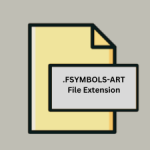.SPR File Extension

Half-Life Sprite
| Developer | Valve |
| Popularity | |
| Category | Raster Image Files |
| Format | .SPR |
| Cross Platform | Update Soon |
What is an SPR file?
The .SPR file extension is associated with the Half-Life video game series, developed by Valve Corporation. These files are used to store sprite graphics, which are two-dimensional images or animations used to represent objects, characters, and other visual elements within the game.
More Information.
The initial purpose of the .SPR file format was to provide an efficient way to handle 2D sprites in a 3D game environment. These sprites are used for various visual effects, such as explosions, muzzle flashes, and other non-polygonal graphics that don’t require 3D modeling.
Origin Of This File.
The .SPR file format was specifically created for the GoldSrc engine, which was used in the original Half-Life game and its modifications. This engine was based on a heavily modified version of the Quake engine by id Software.
File Structure Technical Specification.
The .SPR file format typically includes the following components:
- Header: Contains metadata about the sprite, such as version information, type of sprite, and number of frames.
- Frames: Each frame is a separate image that makes up part of an animation. The frames are stored in sequence and can be played back to create animated effects.
- Palette: Contains color information for the sprite, usually in a 256-color palette.
- Bounding Bo
How to Convert the File?
Windows
- Sprite Explorer:
- Download and install Sprite Explorer.
- Open the
.SPRfile in Sprite Explorer. - Use the export function to save individual frames as
.PNGor.BMPfiles.
- Jed’s Half-Life Model Viewer:
- Download and install Jed’s Half-Life Model Viewer.
- Open the
.SPRfile. - Export the frames using the built-in export options.
Linux
- Wine with Windows Tools:
- Install Wine on your Linux distribution.
- Run Sprite Explorer or Jed’s Half-Life Model Viewer through Wine.
- Follow the same steps as for Windows to export the frames.
- Custom Scripts:
- Use a Python script to read and extract frames from the
.SPRfile. - Save the extracted frames as
.PNGor.BMPfiles.
- Use a Python script to read and extract frames from the
macOS
- Wine with Windows Tools:
- Install Wine on your macOS.
- Run Sprite Explorer or Jed’s Half-Life Model Viewer through Wine.
- Follow the same steps as for Windows to export the frames.
- Virtual Machines:
- Run a Windows virtual machine using Parallels, VMware, or VirtualBox.
- Install and use Sprite Explorer or Jed’s Half-Life Model Viewer within the VM.
Android
- Xash3D Android Port:
- Use the Xash3D Android Port to run the Half-Life engine on your Android device.
- Extract sprites using the engine’s built-in tools or custom scripts.
- Termux and Custom Scripts:
- Install Termux on your Android device.
- Use Python scripts to extract frames from the
.SPRfile.
Example Python script (similar to the Linux example) can be run in Termux.
iOS
- Remote Access:
- Use a remote desktop application to access a Windows PC or VM that has Sprite Explorer or Jed’s Half-Life Model Viewer installed.
- Convert the
.SPRfiles remotely.
- Emulators:
- Use an emulator like iDOS to run Windows tools directly on your iOS device.
Others
- Cross-Platform Tools:
- Use game development tools like Unity with custom scripts to import and convert
.SPRfiles.
- Use game development tools like Unity with custom scripts to import and convert
- Online Conversion Services:
- Use online services that support custom file conversions, though these are rare for
.SPRfiles and may require manual configuration.
- Use online services that support custom file conversions, though these are rare for
- Custom Development:
- Write custom scripts or use existing libraries to handle
.SPRfiles in other environments or applications.
- Write custom scripts or use existing libraries to handle
Advantages And Disadvantages.
Advantages:
- Efficiency: Allows for the efficient storage and rendering of 2D graphics in a 3D environment.
- Simplicity: Easier to create and manage compared to 3D models, especially for simple effects and objects.
- Performance: Can improve game performance by using simpler graphics for certain elements.
Disadvantages:
- Limited Detail: Not suitable for complex or highly detailed graphics.
- Resolution Constraints: May not scale well to higher resolutions or modern displays.
- Compatibility: Primarily used in older games, limiting its utility in modern game development.
How to Open SPR?
Open In Windows
- Sprite Explorer: A tool specifically designed to view and extract sprites from Half-Life.
- Jed’s Half-Life Model Viewer: A more general tool for viewing models and sprites from Half-Life.
Open In Linux
- Wine: Run Windows-based tools like Sprite Explorer through Wine.
- Custom Scripts: Use custom Python or Perl scripts to extract and view sprite frames.
Open In MAC
- Wine: Similar to Linux, use Wine to run Windows-based tools.
- Virtual Machines: Run a Windows virtual machine using software like Parallels or VMware.
Open In Android
Xash3D Android Port: Use this port of the GoldSrc engine to run Half-Life and view .SPR files within the game environment.
Open In IOS
Due to the closed nature of the iOS ecosystem, there are limited options for directly opening .SPR files. Using emulators or ports of the GoldSrc engine might be necessary.
Open in Others
Cross-Platform Game Development Tools: Some game development tools and engines may have plugins or extensions to handle .SPR files.













